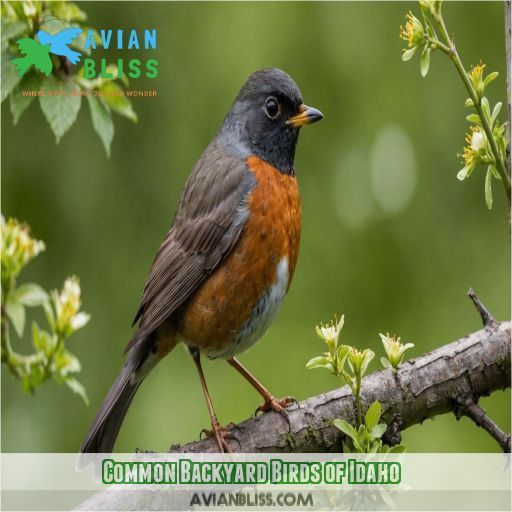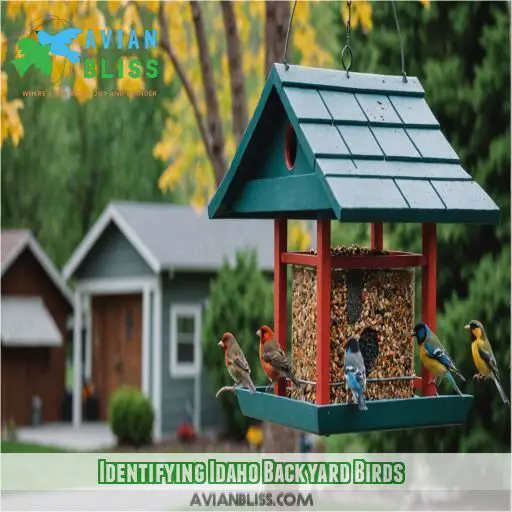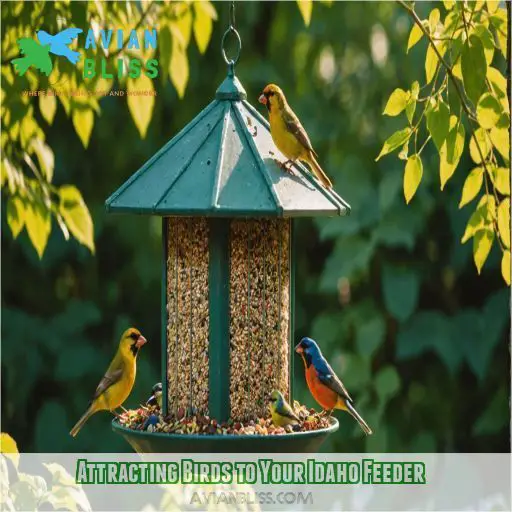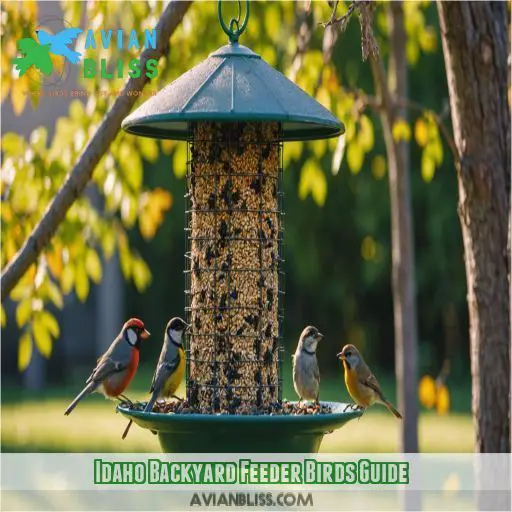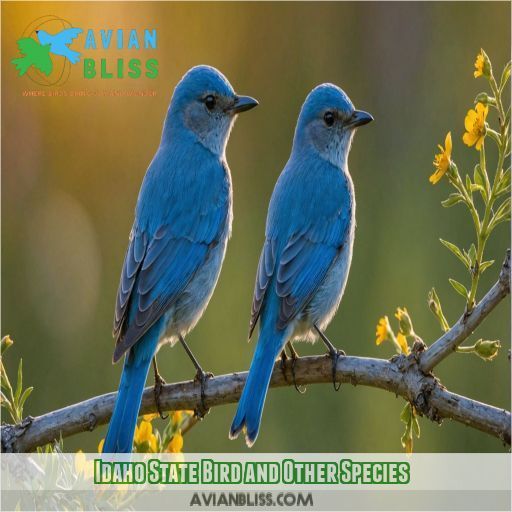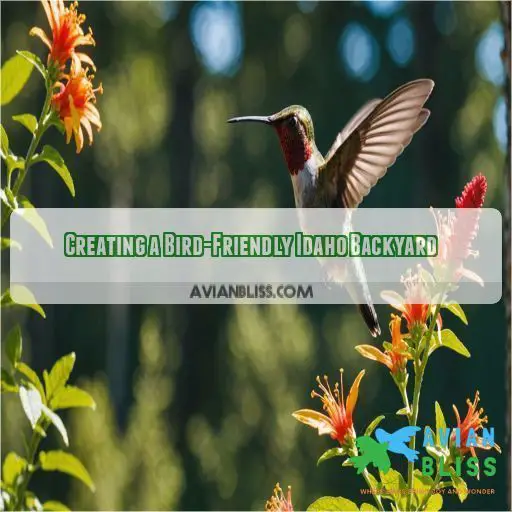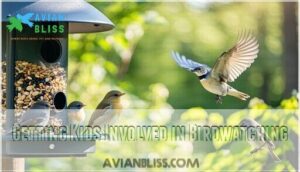This site is supported by our readers. We may earn a commission, at no cost to you, if you purchase through links.
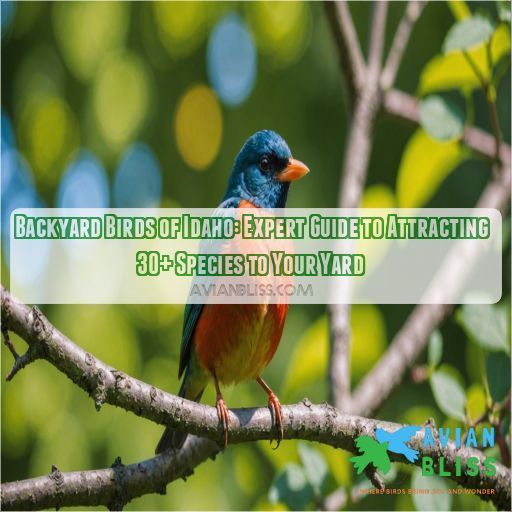
Start by getting to know the locals!
You’ll spot American Robins with their cheerful songs, Black-billed Magpies with their striking coats, and Northern Flickers with their drumming antics.
With the right feeders and seeds, you can attract over 30 species of backyard birds of Idaho.
But, it’s not just about throwing some seeds out there – understanding their habits, habitats, and quirks is key.
By creating a bird-friendly oasis, you’ll be rewarded with a daily spectacle of feathers, songs, and fascinating behaviors.
Your birding adventure is just taking flight!
Table Of Contents
- Key Takeaways
- Common Backyard Birds of Idaho
- Identifying Idaho Backyard Birds
- Attracting Birds to Your Idaho Feeder
- Idaho Backyard Feeder Birds Guide
- Birdwatching in Idaho
- Idaho State Bird and Other Species
- Creating a Bird-Friendly Idaho Backyard
- Backyard Bird Feeding Tips
- Idaho Backyard Bird Conservation
- Getting Kids Involved in Birdwatching
- Frequently Asked Questions (FAQs)
- How do I identify a bird in my yard?
- What is the most common bird in Idaho?
- Is it good to have birds in your backyard?
- What is the best bird feed for Idaho?
- What is the best time of year for birdwatching?
- How can I deter unwanted birds from my feeder?
- Can I use pesticides in my bird-friendly backyard?
- Are there any local birdwatching groups in Idaho?
- Can I raise orphaned birds in my backyard?
- Conclusion
Key Takeaways
- You’ll be amazed at the variety of birds you can attract to your Idaho backyard—over 30 species, to be exact—by offering the right food, water, and shelter. It’s not just about throwing some seeds out there, though; understanding their habits, habitats, and quirks is key to creating a bird-friendly oasis.
- To identify the fascinating creatures that visit your Idaho yard, focus on key features like size, shape, color, beak, and behavior. Don’t be afraid to use a Bird Identification guide or app to help you get started on your birding journey—and remember, practice makes perfect!
- Creating a bird-friendly habitat in your Idaho yard is easier than you think, and it all starts with native plants, which are a bird magnet, offering food and shelter. Add some water sources, like birdbaths or small ponds, and provide shelter options, such as dense shrubs or birdhouses, and you’ll be well on your way to attracting a diverse range of feathered friends.
- By participating in citizen science projects, like the Cornell Lab of Ornithology’s FeederWatch, you can help collect data on bird populations and distribution, which aids conservation efforts and enhances our understanding of birds like the American crow and red-tailed hawk—and the best part is, you can do it all from the comfort of your own backyard!
Common Backyard Birds of Idaho
As you step into your Idaho backyard, you’re likely to spot some familiar feathered friends, including the American Robin, Black-billed Magpie, Mallard, House Finch, and Northern Flicker . These common birds are just a few of the many species you can attract to your yard with the right food, water, and shelter, and learning about their habits and habitats is the first step to creating a bird-friendly oasis .
American Robin
In your Idaho backyard, you’ll likely spot the American Robin, with its distinctive brick-red breast and cheerful song. These worm-hunting experts build cup-shaped nests in trees, often using mud and twigs. Attract them with a mix of lawn and trees, and offer mealworms or fruit. Enjoy watching their lively antics, and appreciate their role in controlling pest populations. The American Robin is a common backyard bird in Idaho, known for its dark gray back and brick-red belly. Find them foraging for worms and bugs on lawns and open grassy areas. Female Robins build cup-shaped nests in trees, often with the help of their male counterparts. Citations:
Black-billed Magpie
Meet the Black-billed Magpie, a striking bird with a glossy black and white coat and a ridiculously long tail.
In Idaho, these clever birds thrive, feeding on carrion, seeds, and insects.
They build elaborate domed nests out of mud and sticks.
Don’t believe the myths – magpies aren’t thieves, just opportunistic omnivores!
Mallard
As you continue to explore the wonderful world of Idaho’s backyard birds, let’s waddle into the wonderful world of Mallards!
These familiar ducks are a delight to spot, with males flaunting their metallic green heads and yellow bills.
Females, on the other hand, are mottled brown and buff.
Keep an eye out for them near shallow water, where they forage for insect larvae and seeds.
House Finch
Your backyard feeder is a perfect spot for the House Finch! These sparrow-sized birds have dark, rounded beaks and males sport vibrant orange-red heads, throats, and breasts. Females are mostly streaked, dull brown-gray. Offer seeds, buds, and fruits to attract them. Keep your feeder clean and well-stocked, and you’ll be enjoying these finches’ sweet songs in no time!
Northern Flicker
Meet the Northern Flicker, a fascinating woodpecker that’s a common sight in Idaho backyards!
With its tan and gray feathers, black spots, and distinctive drumming behavior, this bird is a treat to spot.
Northern Flickers feast on ants, beetles, and seeds, and nest in tree cavities.
Create a welcoming habitat by offering suet and sunflower seeds, and get ready to enjoy their lively drumming sessions!
Identifying Idaho Backyard Birds
You’re about to become a backyard bird expert, and it all starts with identifying the fascinating creatures that visit your Idaho yard. By learning the key identification features, field marks, and habitat preferences of Idaho’s backyard birds, you’ll be able to tell a Black-billed Magpie from a Northern Flicker in no time.
Key Identification Features
Get to know your feathered friends! To identify Idaho’s backyard birds, focus on key features: size, shape, color, beak, and behavior. Note the bird’s overall proportions, plumage patterns, and beak shape. Observe how it moves, forages, and interacts with others. Use a bird identification guide or app to help you get started on your birding journey!
Field Marks and Habitat Preferences
To identify your Idaho backyard birds, pay attention to field marks like wing bars, tail patterns, and head markings. Habitat clues can also help – think about where you’re seeing the bird. Is it near water or in a tree? Consult field guides to learn more about your local species. Start with common visitors like finches, sparrows, and chickadees.
Bird Songs and Calls
Bird songs and calls are like nature’s soundtrack, and each species has its unique tune.
These vocalizations serve as a form of communication, helping birds assert territory, attract mates, or warn of danger.
From the complex songs of the mockingbird to the cheerful chirps of the song sparrow, paying attention to these auditory cues can help you identify birds.
Keep an ear out for the varied and beautiful bird songs and calls in Idaho’s backyards.
Observing Birds in Flight
Bird flight reveals clues about a species.
Check wing shapes and tail patterns for identification hints.
A soaring hawk’s flight pattern differs from a woodpecker’s.
Observe migration routes and flocks for variety.
Study flight paths and destinations.
Each species has unique patterns, like the V-formation of Canada Geese.
Bird distribution and population data offer insights into their habits and needs.
Enjoy the dance of bird flight while contributing to citizen science.
Attracting Birds to Your Idaho Feeder
Want to turn your Idaho yard into a bustling bird paradise? From strategic feeder placement to offering a variety of birdseed mixes, we’ll show you how to make your space irresistible to our feathered friends.
Types of Bird Feeders
Now that you know which birds to look out for, let’s talk about the different types of bird feeders you can set up in your Idaho backyard to attract a diverse range of feathered friends, including bird feeder options with a variety of bird feeder styles
. Here are some common bird feeder styles to check out:
- Platform feeders: These are basically trays that hold bird seed, which attracts ground-feeding birds like sparrows and finches.
- Hopper feeders: They’ve a container to hold the bird seed and a feeding tray below, offering a perch for birds to feed.
- Tube feeders: These are cylindrical and often made of plastic or metal, with small holes for birds to access seeds. They’re great for smaller birds like finches and chickadees.
- Suet feeders: Suet is animal fat, and these feeders offer a high-energy treat, especially for insect-eating birds. Woodpeckers love ’em!
- Window feeders: These attach to windows, giving you an up-close view of your feathered visitors.
Birdseed Options and Preferences
To attract a variety of birds to your Idaho feeder, consider their preferences and offer a range of seeds and mixes. Here are some options:
| Bird Type | Birdseed Types |
|---|---|
| Finches | Nyjer (thistle) seeds |
| Woodpeckers | Suet (beef fat) |
| Chickadees | Peanut butter |
| Jays | Dried whole-kernel corn |
| Doves | Cracked corn |
Strategic Feeder Placement
Once you’ve got the right seeds and feeders, it’s time for placement. After all, you don’t want to serve a feast in a ghost town or, worse, a danger zone. Here’s how to pick a spot that birds will flock to:
- Feeder height: Hang feeders at chest height or higher to keep them out of reach of cats and other predators.
- Predator protection: Place feeders near bushes or trees, giving birds a quick escape route from hawks or cats.
- Bird traffic: Keep feeders away from windows to avoid bird strikes.
- Shade: Birds overheat quickly, so locate feeders near shade-giving trees or shrubs.
Creating a Bird-Friendly Habitat
Creating a bird-friendly habitat in your Idaho yard is key to attracting feathered friends.
Native plants are a bird magnet, offering food and shelter.
Add water sources, like birdbaths or small ponds, for drinking and bathing.
Provide shelter options, such as dense shrubs or birdhouses.
Protect your visitors by keeping cats indoors and providing safe nesting areas, like thorny bushes, away from predators.
Idaho Backyard Feeder Birds Guide
Idaho is home to a diverse array of birds, and with the right knowledge, you can attract a variety of feathered friends to your backyard. In this guide, we’ll introduce you to the most common backyard feeder birds in the state, providing tips on identification, feeding, and creating a bird-friendly space.
Sparrows, Finches, and Allies
Sparrows, finches, and their allies are ground-feeding specialists, often visiting platform, hopper, or tube feeders. These birds are a common sight in Idaho backyards, with a variety of species to spot. Keep an eye out for the white-crowned sparrow, pine siskin, American goldfinch, and dark-eyed junco. You might also spot the lesser goldfinch, a tiny, bright yellow bird.
Doves and Pigeons
Doves and pigeons are common visitors to Idaho backyards.
Mourning doves, with their soft coos, and the larger Eurasian collared-doves are the most frequent feathered guests.
These gentle birds are entirely vegetarian, using their weak bills to pick up seeds and grains.
They nest in trees, building flimsy platforms of twigs and grass.
Rock pigeons, on the other hand, are more likely to make their homes on buildings and window ledges in urban areas.
Blackbirds and Their Allies
If you’re talking about blackbirds and their buddies in Idaho, you’ll see how adaptable they are. Red-winged blackbirds, for example, eat seeds, grains, and insects. They’re common visitors to backyard feeders, especially if you offer sunflower seeds or cracked corn. Keep an eye out for their distinctive red and black plumage, and enjoy their melodic songs.
Mockingbirds, Thrashers, and Catbirds
In Idaho, you can attract mockingbirds, thrashers, and catbirds to your backyard feeder with the right food and habitat.
These birds love insects and fruits, so offer mealworms and berries.
Idaho mockingbirds are known for their mimicry, while thrashers have distinctive nesting habits.
Create a bird-friendly habitat with native vegetation and a source of water to entice these birds to stay.
Starlings
Starlings are the uninvited guests at your feeder.
They’re bold and bully other birds, so it’s no wonder they’re often unwelcome.
Introduced from Europe, these birds are common across North America.
Starlings eat almost anything and go wherever they please.
Their diet includes insects, fruit, seeds, and even your leftovers.
Keep an eye out for their iridescent feathers and beaky grin!
Birdwatching in Idaho
Birdwatching in Idaho opens a window to a diverse ecosystem, with over 432 species spotted in the state. From your backyard, you can enjoy the hobby and contribute to citizen science by participating in bird counts and sharing your observations.
Fun Activities for Your Backyard
Birding opens a world of fun in your backyard. Get the gang involved in a bird count, spotting and tallying species. Try birdhouse building, crafting feeders, and creating birdbaths. Kids love it! Bird photography’s a hoot, snapping pics of feathered friends. Get schooled in bird sounds, learning their unique calls. It’s a blast, boosting your bird awareness and appreciation.
Participating in Citizen Science
Citizen science is a rewarding way to blend birdwatching with contributing to scientific research. By participating in projects like the Cornell Lab of Ornithology’s FeederWatch, you can help collect data on bird populations and distribution. This data aids conservation efforts and enhances our understanding of feathered friends like the American crow and red-tailed hawk. Your observations truly make a difference!
Understanding Bird Populations and Conservation
Understanding Bird Populations and Conservation is really important for bird enthusiasts. Your backyard birding hobby can contribute to the bigger picture. Here are some key things to keep in mind:
- Bird migration patterns and habitat loss
- Climate impact on bird populations
- Joining citizen science projects like the Cornell Lab of Ornithology
- Supporting local conservation efforts
- Making a difference, one bird at a time, like saving the American Crow
Connecting With Nature
Connecting With Nature (Birdwatching in Idaho)
You’re ready to deepen your connection with nature! As you observe the fascinating world of birds, remember to appreciate the little things. Take a moment to breathe in the fresh air, listen to the songs, and feel the sun’s warmth.
| Activity | Benefits | Tips |
|---|---|---|
| Nature photography | Improves observation skills | Start with a smartphone camera |
| Birdwatching tips | Enhances patience and focus | Begin with common species like the American Robin |
| Nature journaling | Fosters creativity and reflection | Record your observations and insights regularly |
Idaho State Bird and Other Species
You’re about to meet the feathered face of Idaho – the stunning Mountain Bluebird – and explore the amazing diversity of birds that call the Gem State home. From majestic birds of prey to melodious songbirds, you’ll discover the fascinating world of Idaho’s bird species and learn how to attract them to your own backyard.
Mountain Bluebird
You’re probably curious to learn about Idaho’s state bird, the Mountain Bluebird! This stunning bird has a pale blue body with a darker blue backside. Here are four fun facts about Mountain Bluebirds:
- They nest in cavities, like tree holes or rock crevices.
- Idaho’s Bluebird habitat includes open meadows and mountainous areas.
- Bluebird conservation efforts focus on protecting their nesting sites.
- Their diet consists mainly of insects, which they catch mid-air!
Birds of Prey and Raptors
Idaho’s vast skies are home to soaring birds of prey and raptors.
To attract these magnificent birds, create a haven with native vegetation and a reliable food source.
Install nest boxes or platforms for species like the Red-tailed Hawk and Great Horned Owl.
Waterfowl and Shorebirds
In Idaho, you can attract waterfowl like Mallards and shorebirds to your backyard with a pond or pool. Plant native vegetation like cattails and water lilies to create a welcoming habitat. Consider installing a bird bath or shallow dish for smaller shorebirds. By providing a haven, you’ll support bird migration and conservation efforts, and enjoy visits from these fascinating birds.
Songbirds and Sparrows
Now that we’ve explored waterfowl and shorebirds, let’s talk about songbirds and sparrows. Idaho’s state bird, the Mountain Bluebird, is a stunning example of a songbird. To attract these birds to your yard:
- Offer mealworms: A favorite snack of many songbirds.
- Use shrub-friendly feeders: Sparrows love hiding in shrubs while snacking.
- Plant native flowers: These provide nectar for songbirds and seeds for sparrows.
Creating a Bird-Friendly Idaho Backyard
You can easily turn your Idaho backyard into a bird-friendly haven by providing the right combination of food, water, shelter, and habitat. By making a few simple changes, such as installing a bird feeder or birdbath and planting native vegetation, you’ll be amazed at the variety of bird species that will start visiting your yard.
Providing Food and Water Sources
Now that we’ve explored Idaho’s state bird and other species, let’s create a welcoming space for them in your backyard. Providing food and water sources is a big deal. Consider offering a variety of seed types, installing a bird bath or water feature, and strategically placing feeders to maximize visibility and accessibility.
| Seed Types | Description |
|---|---|
| Safflower seeds | Attract finches and sparrows, while deterring squirrels |
| Sunflower seeds | Favorited by cardinals and chickadees |
| Nyjer seeds | High in oil, perfect for finches and sparrows |
| Suet | Energy-rich, ideal for woodpeckers and nuthatches |
| Fresh fruits | Enjoyed by orioles, robins, and blue jays |
Creating Shelter and Habitat
Now that you’ve got the food and water sources covered, it’s time to think about shelter and habitat. You want to create a cozy little haven for your feathered friends to hang out, nest, and raise their young. Here’s what you can do:
- Plant native plants, shrubs, and trees to provide cover and nesting sites
- To attract species like bluebirds, consider building or installing a bird house with a 1.5 inches entrance hole, following a bluebird house guide. Install nesting boxes for species like bluebirds and swallows
- Create a diverse habitat with a mix of grasses, flowers, and shrubs
- Provide predator protection with thorny plants or a fence
- Leave some areas of your yard untidy to offer hiding spots and foraging opportunities
Using Bird Feeders and Baths
Now that you’ve created a sheltered habitat, it’s time to bring in the bird feeders and baths. Place feeders at least 3 feet away from any structures to prevent collisions. For winter feeding, use a heated birdbath or change the water frequently to keep it from freezing. This will attract hummingbirds and other birds that need a reliable water source.
Planting Native Vegetation
Planting native vegetation is a game-changer for creating a bird-friendly Idaho backyard. By choosing plants native to your region, you’ll provide a haven for local birds and support pollinators. Here are some ideas to get you started:
- Incorporate shrubs like sagebrush or serviceberry to offer berries and shelter.
- Plant native wildflowers like lupine or camas to attract pollinators.
- Choose native grasses like bluebunch wheatgrass to provide nesting sites.
- Select trees like cottonwood or aspen to offer shade and food sources.
Backyard Bird Feeding Tips
As you start attracting birds to your Idaho backyard, you’ll want to make sure you’re providing the best possible experience for these feathered friends. By following some simple backyard bird feeding tips, you can create a haven that will keep your avian visitors happy and healthy, and keep you entertained for hours on end.
Choosing the Right Birdseed
Choosing the right birdseed can be overwhelming, but don’t worry, I’m here to help! Consider the types of birds you want to attract and their preferences. Mixes with sunflower seeds, nuts, and fruits are crowd-pleasers. Suet and nyjer seeds are great for woodpeckers and finches. Budget-friendly options like millet and oats are perfect for sparrows and doves.
Maintaining a Clean Feeder
Now that you’ve chosen the right birdseed, it’s super important to maintain a clean feeder to prevent disease and mold. Clean your feeder every 1-2 weeks with soap and warm water. Rinse thoroughly and dry with a clean towel. This simple habit will keep your feathered friends healthy and happy. Remember, a clean feeder is a welcoming feeder!
Offering Fresh Water
Now that your feeder is clean, let’s talk about water! Providing fresh water is really important for attracting birds to your yard. Consider installing a birdbath or a shallow dish with fresh water and a few rocks for perching. Change the water frequently to keep it clean, and add a heater or change the water often to prevent freezing.
Avoiding Common Feeding Mistakes
Now that you’re offering fresh water, let’s tackle common feeding mistakes!
Don’t store birdseed in humid areas, as it can grow mold.
Clean your feeders regularly to prevent bacterial growth.
Place feeders at least 3 feet away from structures to avoid collisions.
Idaho Backyard Bird Conservation
As you create a welcoming habitat for Idaho’s backyard birds, you’re also contributing to their conservation – a win-win for both you and these amazing creatures. By making a few simple tweaks to your yard and staying informed about local conservation efforts, you can help protect the state’s incredible avian diversity and keep those birds singing for years to come.
Understanding Bird Migration Patterns
As you welcome birds to your Idaho backyard, understanding their migration patterns can enhance your birdwatching experience. Migration timing varies among species, but many birds travel through Idaho’s central flyway. Climate change affects these routes, so tracking methods like bird banding can provide valuable insights. By recognizing these patterns, you’ll better appreciate the amazing journeys of your feathered friends.
Creating a Bird-Friendly Community
Let’s create a bird-friendly community in Idaho. You can make a difference by:
- Starting a backyard bird club to share tips and spot species together
- Participating in citizen science projects to track bird migrations and populations
- Collaborating with local bird sanctuaries to create bird-friendly landscaping and habitats in public spaces
Supporting Local Conservation Efforts
You’re making a difference by creating a bird-friendly community, now let’s take it to the next level by supporting local conservation efforts. Join bird conservation groups, visit local wildlife refuges, and participate in citizen science projects. These actions help protect birds and also enrich your connection with nature.
| Conservation Action | Benefits to Birds | Benefits to You |
|---|---|---|
| Join bird conservation groups | Protects bird habitats, supports research | Networking, learning opportunities |
| Visit local wildlife refuges | Provides important habitat for birds | Inspires, educates, and entertains |
| Participate in citizen science | Informs bird conservation decisions | Develops skills, builds community |
| Create a bird-friendly backyard habitat | Supports local bird populations | Enhances your outdoor space |
Reducing Bird Window Collisions
You’re supporting local conservation efforts, now let’s tackle reducing bird window collisions! Apply window decals or install bird-safe glass to prevent fatal crashes. Use window treatments like curtains or blinds to minimize reflective surfaces. Move plants away from windows to reduce the illusion of a clear flight path. Every prevention tip counts in saving our feathered friends!
Getting Kids Involved in Birdwatching
You can spark a lifelong passion for birdwatching in kids by making it a fun, interactive experience in your own Idaho backyard. By teaching them how to identify birds, participate in citizen science projects, and create a bird-friendly habitat, you’ll be sharing your love of nature and helping to foster the next generation of bird enthusiasts and conservationists .
Fun Activities for Kids
Getting kids involved in birdwatching is a great way to foster a love for nature and conservation. Make it fun with activities like:
- Creating bird crafts, like feathered friends made from construction paper
- Building DIY feeders using peanut butter and seeds
- Taking nature walks to spot local bird species
- Learning to mimic bird songs
- Playing bird games, like "I Spy" with binoculars
Teaching Kids About Bird Identification
Now that you’ve got your kids excited about birdwatching, it’s time to teach them about bird identification! Start with the basics: show them how to use bird field guides, download bird identification apps, and play birdwatching games together. Create a DIY bird feeder or take nature walks to spot different species and make learning a fun, hands-on experience.
Encouraging Kids to Participate in Citizen Science
Now that your kids can identify birds, encourage them to participate in citizen science projects. Download birdwatching apps like eBird or Merlin Bird ID, and have them record their sightings. Keep a nature journal to track their progress. Organize local outings to nearby parks or nature reserves, and make bird feeder fun a regular activity.
Creating a Kid-Friendly Backyard Bird Habitat
Transform your backyard into a kid-friendly bird haven! Install bird feeders and nest boxes at kid-friendly heights. Choose safe plants like sunflowers or coneflowers that attract birds. Add a shallow bird bath for splashing fun. Engage your little ones in DIY projects, like building a birdhouse or creating a bird-friendly garden. Watch their curiosity and wonder grow!
Frequently Asked Questions (FAQs)
How do I identify a bird in my yard?
Let’s say you spot a bird with a distinctive orange-red head, throat, and breast in your yard – it’s likely a male House Finch! To identify birds, focus on size, shape, color patterns, beak shape, and behavior.
What is the most common bird in Idaho?
You’re curious about Idaho’s most common bird? It’s the American Robin! With its distinctive brick-red breast and cheerful song, this bird is a familiar friend in many backyards. You might spot one foraging for worms on your lawn.
Is it good to have birds in your backyard?
Having birds in your backyard is a wonderful idea! They add a touch of music and beauty, and they also help with pest control and fertilization – it’s like having your own tiny, feathered clean-up crew!
What is the best bird feed for Idaho?
You’re wondering what’s the best bird feed for Idaho? Well, consider a mix that’s rich in seeds, nuts, and fruits to attract a variety of species, and don’t forget to include some Nyjer seed for those finicky finches!
What is the best time of year for birdwatching?
You’re in for a treat! The best time for birdwatching in Idaho is during spring and summer months , but late summer and early fall are also great, especially for spotting migrant shorebirds .
How can I deter unwanted birds from my feeder?
You can deter unwanted birds from your feeder by using weight-activated perches, cage-like enclosures, or seed types that attract specific species. Try offering alternative food sources, like suet or fruit, to distract unwanted visitors.
Can I use pesticides in my bird-friendly backyard?
You might be tempted to use pesticides, but don’t – they can harm birds and other beneficial wildlife. Instead, adopt natural methods to control pests, like attracting beneficial insects or using physical barriers to protect your plants.
Are there any local birdwatching groups in Idaho?
You’re not alone in your birding adventures! Join local groups like the Idaho Audubon Society or the Idaho Birding Trail, which offer guided tours, workshops, and opportunities to connect with fellow bird enthusiasts across the state.
Can I raise orphaned birds in my backyard?
You’re tempted to raise those adorable orphaned birds in your backyard, but hold on! It’s really important to contact local wildlife rehabilitation centers instead, as they’ve the expertise and facilities to provide the best care.
Conclusion
Get ready for the most epic backyard bird party in Idaho!
With over 30 species to attract, your yard will be the go-to hotspot for feathered friends.
By mastering the art of bird-friendly habitats, seed selection, and feeder placement, you’ll be the ultimate host for Idaho’s backyard birds.
As you bask in the joy of your newly-created bird haven, remember: every chirp, tweet, and flutter is a sign of your success in creating a haven for Idaho’s incredible backyard birds.

